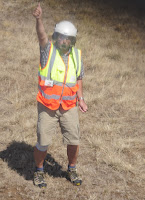Flight number five: catching stratocumulus clouds
Due to pilot’s working
regulations, we had a day off yesterday. While exploring the island’s nature
that day, we could observe the perfect stratocumulus cloud cover, that the
cloud group was desperately looking for after several cloud-free aerosol
flights with ACTOS.
When getting up this
morning, the cloud cover was still present, overcast, but predicted to decay throughout
the day. So we headed towards the airport earlier. When arriving there, we
still had to wait outside due to a delayed inter-islands flight and meanwhile
the clouds became fewer and fewer.
 |
| Graciosa with almost clear sky |
Finally, at 10:30, ACTOS took off into an almost clear sky over the airport. Most of the cloud cover had disappeared. At some distance, we observed isolated smaller stratocumulus cloud fields. As fast as possible, we tried to reach one of them, which we found east of the island just inside the 10 nautical miles zone. ACTOS flew through the SC cloud field in 1400m for five minutes, but it was very thin with a liquid water content of just 0.2g/m3 and after turning around, it already had started to decay.
 |
| Thin SC cloud with a glory around the helicopter shadow |
But what was about to form behind us? An isolated cloud patch, not really stratocumulus, rather with some remarkable convective structures. Looked like a great opportunity to measure a really interesting cloud, so we decided to fly back.
 |
| The pilots heading towards the cloud field |
We had not expected too much. We found the (strato?)cumulus cloud field in about 1300m altitude, below the strong temperature inversion layer with a temperature gradient of 5K within 50m. We flew several legs through the clouds in different directions, trying to keep ACTOS inside the cloud and HELIOS and the helicopter above. The cloud field itself was highly inhomogeneous with a very variable cloud top structure and vertical extend. At some points, one could see through the cloud, at other points the helicopter almost dived into the cloud, meanwhile ACTOS, flying 150m below, was still inside. One could also watch the cloud tops moving, shreds of clouds forming and disappearing and even observe some features resembling Kelvin-Helmholtz instabilities. The LWC was considerably above 1g/m3 inside the cloud. The vertical airmass movements up to 4m/s were clearly sensible in the helicopter and made accurate flying more complicated than usual. We also observed some peaks in particle concentration.
 |
| Kelvin-Helmholtz instabilities at the cloud tops |
We completed the measurements with one leg flying ACTOS above the cloud and after that diving through the cloud from above and from below. The wind was blowing us away from the airport, so we had to return after probing the cloud for more than half an hour.
 |
| The SC cloud field with convective dynamics when returning to the airport |
We are very satisfied about the unique opportunity to measure such a highly dynamic and active cloud. At a first glance, all sensors have worked, so we are very much looking forward to analyze the data and learn more about this special cloud.
Posted by Ulrike
Pictures by Holger



Kommentare
Kommentar veröffentlichen